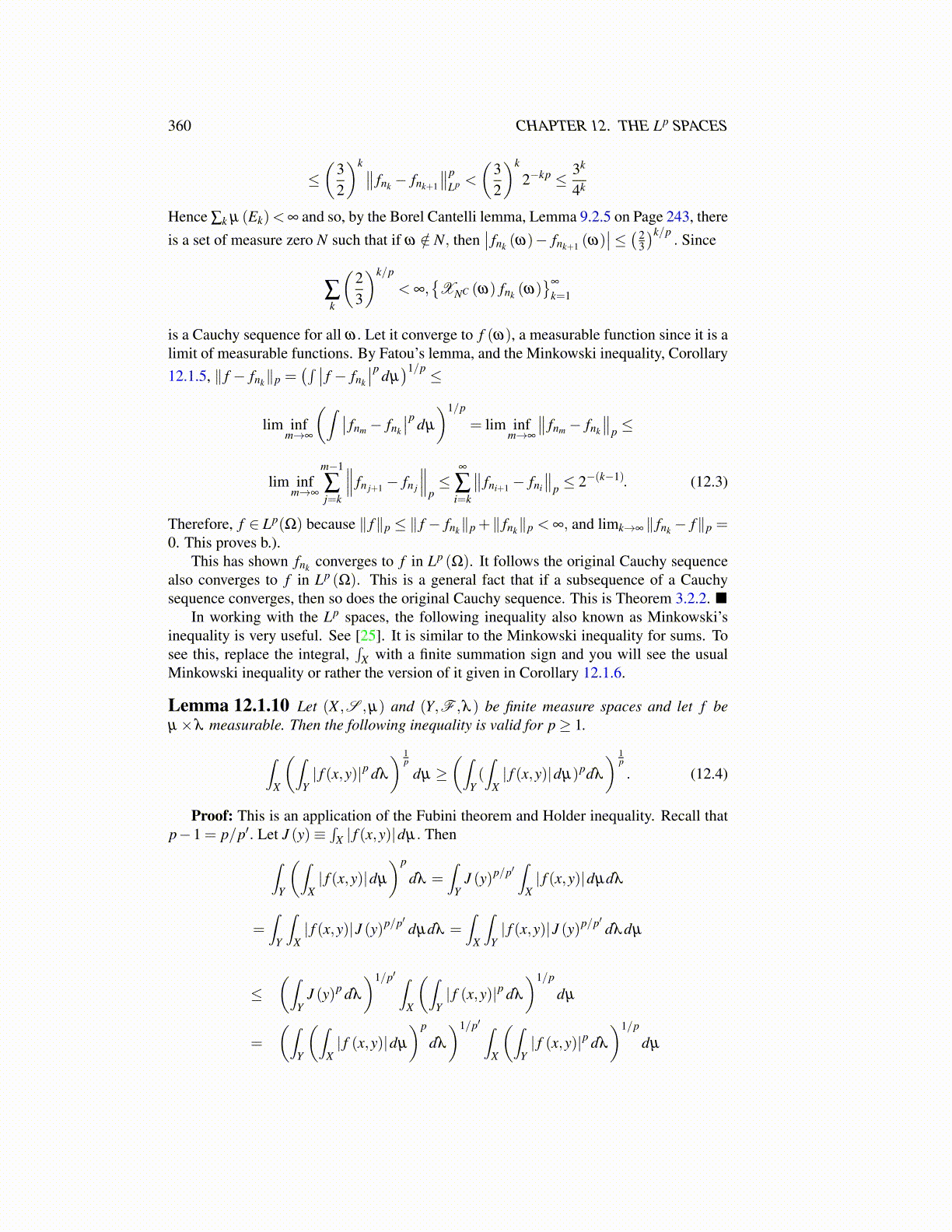
360 CHAPTER 12. THE Lp SPACES
≤(
32
)k ∥∥ fnk − fnk+1
∥∥pLp <
(32
)k
2−kp ≤ 3k
4k
Hence ∑k µ (Ek)< ∞ and so, by the Borel Cantelli lemma, Lemma 9.2.5 on Page 243, thereis a set of measure zero N such that if ω /∈ N, then
∣∣ fnk (ω)− fnk+1 (ω)∣∣≤ ( 2
3
)k/p. Since
∑k
(23
)k/p
< ∞,{XNC (ω) fnk (ω)
}∞
k=1
is a Cauchy sequence for all ω. Let it converge to f (ω), a measurable function since it is alimit of measurable functions. By Fatou’s lemma, and the Minkowski inequality, Corollary12.1.5, ∥ f − fnk∥p =
(∫ ∣∣ f − fnk
∣∣p dµ)1/p ≤
lim infm→∞
(∫ ∣∣ fnm − fnk
∣∣p dµ
)1/p
= lim infm→∞
∥∥ fnm − fnk
∥∥p ≤
lim infm→∞
m−1
∑j=k
∥∥∥ fn j+1 − fn j
∥∥∥p≤
∞
∑i=k
∥∥ fni+1 − fni
∥∥p ≤ 2−(k−1). (12.3)
Therefore, f ∈ Lp(Ω) because ∥ f∥p ≤ ∥ f − fnk∥p +∥ fnk∥p < ∞, and limk→∞ ∥ fnk − f∥p =0. This proves b.).
This has shown fnk converges to f in Lp (Ω). It follows the original Cauchy sequencealso converges to f in Lp (Ω). This is a general fact that if a subsequence of a Cauchysequence converges, then so does the original Cauchy sequence. This is Theorem 3.2.2. ■
In working with the Lp spaces, the following inequality also known as Minkowski’sinequality is very useful. See [25]. It is similar to the Minkowski inequality for sums. Tosee this, replace the integral,
∫X with a finite summation sign and you will see the usual
Minkowski inequality or rather the version of it given in Corollary 12.1.6.
Lemma 12.1.10 Let (X ,S ,µ) and (Y,F ,λ ) be finite measure spaces and let f beµ×λ measurable. Then the following inequality is valid for p≥ 1.
∫X
(∫Y| f (x,y)|p dλ
) 1p
dµ ≥(∫
Y(∫
X| f (x,y)|dµ)pdλ
) 1p
. (12.4)
Proof: This is an application of the Fubini theorem and Holder inequality. Recall thatp−1 = p/p′. Let J (y)≡
∫X | f (x,y)|dµ. Then∫
Y
(∫X| f (x,y)|dµ
)p
dλ =∫
YJ (y)p/p′
∫X| f (x,y)|dµdλ
=∫
Y
∫X| f (x,y)|J (y)p/p′ dµdλ =
∫X
∫Y| f (x,y)|J (y)p/p′ dλdµ
≤(∫
YJ (y)p dλ
)1/p′ ∫X
(∫Y| f (x,y)|p dλ
)1/p
dµ
=
(∫Y
(∫X| f (x,y)|dµ
)p
dλ
)1/p′ ∫X
(∫Y| f (x,y)|p dλ
)1/p
dµ